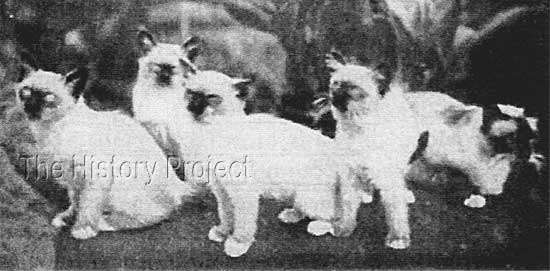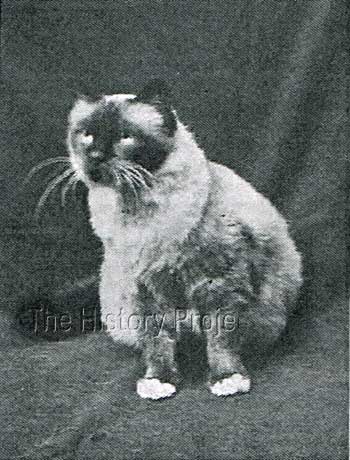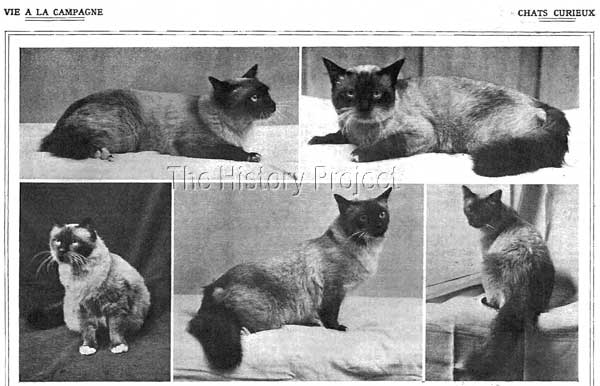 | |||||||||||||||









|
POUPEE DE MADALPOUR (1920)PHOTOS | SOCIAL MEDIA | REFERENCES
HISTORICAL BACKGROUND:'Poupee de Madalpour' stands at the apex of the Birman family tree, being the first and only known Birman of pure ancestry to be born in the West, specifically in Nice, France. With the exception only of her imported dam, she was also the only other fully Birman cat of pure ancestry, living in Europe at the time. It was to be from her, that the first and all known progenitors of the Birman breed developed in the West, were ultimately descended. The breed we know today as the 'Sacred Cat of Burma', has been successfully developed, established and re-established, against what today seems like almost insurmountable odds; surviving the critical loss of the only pure male progenitor during importation, the difficulty of finding and selecting viable outcrosses, obtaining recognition for their unique blend of history and phenotypical traits, then miraculously surviving tragic losses both before and during the Second World War. And as if that were not enough, the breed ultimately faced almost entirely the same set of hurdles yet again, during another re-establishment period, post war. Yet, somehow, the Birman has not only survived all these social and historic set-backs, but has eventually emerged as one of the most beloved and respected of modern-day pedigreed breeds; a strikingly beautiful and unique semi-longhair, that can trace its origins back to the mystical underground temple of 'Lao Tsun' in a remote northern corner of Burma, from where it brings into our midst, its exceptional beauty, its sublime grace, and the mystical majesty of those deep sapphire blue eyes, inherited from the Goddess Tsun Kyan-Kse. PARENTAGE & OWNERSHIP:
Unknown
Madalpour (died during importation)
| Unknown
Poupee de Madalpour, 1920, Seal Point Birman, F
| Unknown
Sita (IMP Burma)
Unknown
The birth and ownership of 'Poupee' is inextricably linked to the drama and mystery surrounding the arrival of her dam 'SITA' into Nice, France in 1920. From the various legends and reports surrounding the importation of the first Birmans, the most likely scenario is that one of the servants from the Temple of Lao Tsun was tempted by high reward to steal and deliver a pair of these sacred cats to a contact of the American multi-millionaire Vanderbilt, whose yacht had been cruising in the far east. The two cats were a male, named 'MADALPOUR' and a female name 'SITA'. One can imagine the scene, with these two cats on board the luxury yacht, cruising across the Indian ocean on a heading intended to ultimately deliver them to France. But fate intervened and we are informed that 'Madalpour' met with an accident on board and subsequently died. But amazingly, it was discovered that the female 'SITA' was already in kitten to him, and in due course, she landed safely at the port in Nice.
There is considerable confusion over who in fact imported the cats, with initial reports indicating that the cats were intended for a Madame Thadde Hadisch of Vienna, but later investigations drew a blank on this connection, and 'Sita' is reported to have delivered her precious litter in Nice, probably under the care and ownership of Madame Leotardi, with whom she appears to have been duly associated from then on. In that litter, was 'POUPEE', who at the time, was considered to being as close to a perfect specimen as had ever been seen. There are sadly no further reports about her dam 'Sita' or what fate she may have met, or whether in fact she was bred from again. Nor are there any surviving photographs of 'Sita'. 'Poupee' therefore, as the only reported survivor from this one full Birman breeding to be born in the west, becomes the sole full Birman progenitrix of the entire Birman breed, and accordingly, takes her rightful place at the very apex of the Birman family tree. SIBLINGS & SHOWS:If indeed there were siblings to 'Poupee' from this first and very precious litter, which is not unlikely, and even if they did or didn't have appropriately marked gauntlets, one can imagine how invaluable a male kitten from this breeding would have been. But sadly there are no records to substantiate any other surviving kittens from 'Sita'. 'Poupee' was certainly shown successfully. And Gisele Barnay advises that the appearance of 'Poupee; was well orchestrated. "She was given good press as they say today."1
In a conversation between Barnay and Simone Poirier published in The Secrets of the Sacred Cat of Burma (translated by Alwyn Hill), Poirier gives some background behind the early shows in France: "Dr. Jumaud was the general secretary of the first French cat club, the Cat Club of France and Belgium; it was founded in 1913. It was he who organized the first show, before the 1914 war."1 Giselle Barnay added, "According to the magazines of the twenties, they had cat shows in provincial locations; in Nice and Cannes from 1912 and in Aix-les-Bains in 1914. They were gradually reintroduced after the war, notably in Cannes in 1923. The great international cat show of Paris in 1926 was the first of its kind. In the history of breeding pedigree cats it was the date which counted." Poirier rejoined, "I believe that it was planned for January 1926 but they had many problems." Barnay then clarified, "The show had to be cancelled in January, due to the cold and the difficulty of keeping the cats warm enough, it was finally held on 14th and 15th May (1926). Approximately 300 cats were shown, mainly very beautiful Persians and Siamese. Jacques Name designed the cover of the catalogue; he was a painter and poet of cats at the time."1 Poirer states, "The Birman cat was an event at that show." And Barnay informs, "I have found some interesting reviews: 'We noticed with great pleasure the interest taken in the Persian cat. The Cat of Burma, so rare, that those admired by the public at Paris are perhaps the only known living examples of the breed'. Only three Birmans were shown but the well-known 'Poupee' was the most remarked-upon. Another comment was: 'good examples of this breed are rare, but those shown were very attractive, in particular 'Poupee de Madalpour' owned by Mme Leotardi presents all the characteristics of the breed.' "1 An interesting commentary, on the earliest exhibition of Birmans shown in France at the time, may be found in the 26th January, 1927 edition of Cat Gossip. The writer is the English Judge, Mrs. Basnett, who makes the following observations: "The sacred Burmese Temple cats interested me very much, with their long fur on the tail and coat resembling that of a poorly bred Persian; their colouring is exactly like that of the Siamese, but their feet sometimes have white toes. I was given to understand that they are very difficult to rear, only about one in ten survive. I do not think they possess the same quick movements as the Siamese, life to them seems much more dreamy and slow, but they are very loving and intelligent."6 It is possible that her comments on the difficulty of breeding them may have confused mortality with an observation made by Phillipe Jumaud who, in an article published in October, 1926 explained the difficulty in obtaining well-marked kittens: "Mme Leotardi, who had has the opportunity to breed more litters, confirms that one should reckon to breed no more than one good one in ten."1 BREEDING & PROGENY:It is assumed that Poupee was the only full Birman female available to be bred, given that no further mention is made of her dam 'Sita'. So this presented a problem in finding a suitable outcross. The earliest report of her outcrossing is to a cat referred to as a 'Loatian Lynx', said to have resembled a Siamese, belonging to a Doctor in Nice. This version of events was affirmed by both Dr. Jumaud and Monsieur Baudoin-Chevoisier in their writings, but the Abbot Marcel Chamonin (aka Marcel Reney) later wrote to the Doctor for historical clarification and was informed, "We have indeed several Siamese cats but know nothing of the origins. I know nothing of Mme Hadisch from Vienna".5 From this clarification it would therefore be reasonable to expect that 'Poupee' was probably bred to a Siamese of 'unknown heritage' owned by the Doctor in Nice at the time. We know not whether this cat would have been shorthaired, or whether he could have been a shorthair carrying the gene for longhair, but as Siamese were already well established as a breed in France by that time, it is not unreasonable to expect that the first kittens from 'Poupee' were all short-haired, pointed, some with. and some without the much-desired gloving.
The various hypotheses regarding options for viable outcrosses were the subject of a discussion between Simone Poirier and Gisele Barney in their Secrets of the Scared Cat of Burma, which is reproduced below1: GB: "According to Marcel Baudoin-Crevoisier, 'Poupee', the grandmother of all our Birmans, was born in Nice." Simone Poirier then exclaims: "If it was an accident, the mysterious Mme Leotardi had a good idea about accidental selection! In any case our hypotheses are plausible: There were Siamese and Persians in France in the Twenties. Anyway, the first valuable result was the famous 'Poupee de Madalpour', the star of the cat show in Paris in 1926. 'Poupee' passed her gloves to many of her descendants. The kittens were kept which had the best-defined gloves, important, as this characteristic is passed on from generation to generation. So the breed came into existence and the Madalpour stock came to show it off."1 At this juncture we must consider more carefully, what Simone is suggesting. Her comment that 'Poupee de Madalour' was the 'first valuable result'. Does this mean she is suggesting that 'Poupee de Madalpour was not the original 'Poupee'? Her comment, in the context it is given, is suggestive that the 'Poupee' shown in 1926 is only a descendant of the 'Poupee' born in Nice, in 1920! This is left to readers to speculate on. It is certainly also quite possible that they were one and the same cat. A cat that was born in 1920, is not an old cat by 1926… and if she was the original 'Poupee' she would have had the expected gloves and long coat. There would also have been time in the intervening years, for her to have been bred a number of times and for subsequent progeny to have matured and likewise either bred back to her or to other half-siblings, or other relatives descended from the same cat. Suffice to say, that in the Birman databases, she is recorded as the daughter of the original 'Sita'.
'Manou de Madalpour' is arguably the most well-known of all progeny from 'Poupee'. He made his show debut with her in 1927. Unlike his known siblings, he was long-haired. Although she is likely to have had a number of litters over the years, and many more kittens than those listed here, the progeny of record for 'Poupee de Madalpour' are:
PHOTOS:
SOCIAL MEDIA :
In Summary: There can be little doubt that 'Poupee' was nothing short of a sensation, when she first appeared at the International Cat Show in Paris in 1926. Here was an actual living example of the rarest of breeds, the mysterious 'Sacred Cat of Burma', with its links back to the lost Temple of Lao Tsun! What is miraculous, is that she produced 'Manou de Madalpour' whom, if we are to believe was from a repeat of the original outcross, was long-haired like his mother. He was certainly a lovely cat, as the photo which has survived of him being held by Marcelle Adams confirms. But regardless of who may have been his sire, he was none-the-less a son of 'Poupee' and as such, a direct descendant of the original Birman male, 'Madalpour', who was so tragically lost during the journey from Burma to France. 'Poupee' may have been the beginning of the Birman breed in France, but she was also unwittingly the foundation of what has become the cult of the Sacred Cat of Burma throughout the world. In this respect she has become an icon, a worldly link to an 'other-worldly' past, to the transmigration of the souls of the kittah-lamas and the worship of the sapphire-eyed goddess, Tsun Kyan-Kse. REFERENCES:
Registers associated with this article include The Incorporated Cat Fanciers Association of Great Britain (TICFAGB), National Cat Club (NCC), The Cat Club (CCR), Beresford Cat Club (BCC), Feline Federation Francaise (FFF), Siamese Cat Registry (SCR), US Register & Studbook for Cats (USR)including Supplement(USRS), The Studbook of the American Cat Association (ACA), and the Studbook & Register of the Cat Fanciers' Association (CFA).
|
||||||||||||||
Home | Cats | Gallery | Clubs | People | Artifacts | Articles | Updates | Contact Us ©The CFA Foundation, Inc and The Harrison Weir Collection
|
|||||||||||||||





